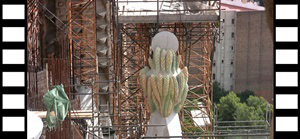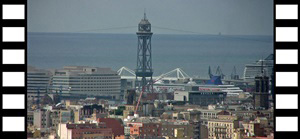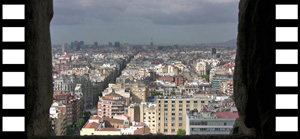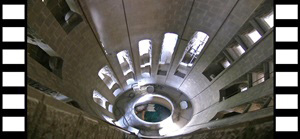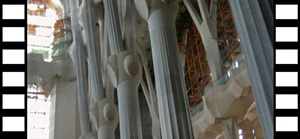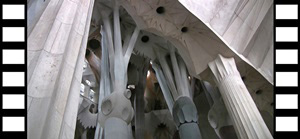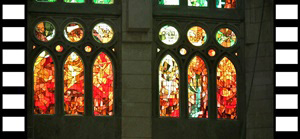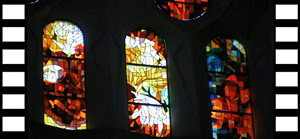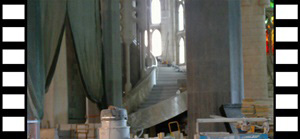As you may recall, when last we visited the Sagrada Família,
there was a discouragingly long and slow-moving line of people waiting to gain entry. While we’d
wanted to see the interior, we didn’t want to spend a good portion of the day waiting to do so, and
we resolved to return later. That evening, as we were recovering from our exertions of that eventful
day, it occurred to us that other in-demand European attractions offered on-line reservations that
had saved us a lot of waiting time. We wondered whether there was a Sagrada Família website, and
whether this hypothetical website featured on-line reservations. We cranked up the netbook and
checked, and as it turned out, there was, and
it did. We quickly signed up, selecting a time
during the morning of our last day in Barcelona. We had to pay in advance, by credit card. We were
sent tickets in the form of a PDF file, which needed to be printed. Unfortunately we had neglected
to pack the all-in-one, so we had to figure out how to get the tickets printed. We put the file on
a USB drive and asked the front desk if they could help, and they said sure, asking out of
curiosity what they were printing. We told them and they seemed surprised that this was possible,
leading us to suspect that on-line ticketing was something new for the Sagrada Família. The desk
attendant printed the tickets without any problems, and we packed them away to await the appointed
time.
On arriving at the church following our quick visit to La Boqueria, we noted a line of people very
similar in length to the one we’d seen previously. We followed it around to the Passion Façade
entrance, but didn’t see any obvious entry point for people with reservations among the waiting
throngs. Off to the right was an unfrequented booth with a bored-looking attendant. We figured it
to be an information booth, and we went over to see if the attendant could answer our question. We
were prepared for a complicated explanation, but the attendant just glanced at our printout and
waved us in through the perimeter fence. I’d be surprised if the reservation system is still this
quick and easy (people must have discovered it by now), but it’s got to be better than standing in
that line.
On passing through the gate, we found ourselves to be much closer to the Passion Façade than we’d
been a couple of days earlier, and we spent a little time close-up with Subirachs' statues.

Below the Façade

Bob and Façade

Crucifixion

The Veronica

The Denial of Peter
We entered the church through a door directly under the façade and found ourselves in
a forest. A forest with a great number of very tall trees, and a canopy of gigantic flowers.
All apparently made of stone or concrete. But there was also stained glass, so it had to be
a church.

Columns and Ceiling

Ceiling, Columns and Nativity Window
While getting our bearings we noticed a short line of people near the entry door. They appeared
to be waiting for an elevator. It seemed obvious that the elevator must ascend one of the towers.
We figured the line would only get longer as the day went on, so we got in line while the wait
was still short, planning to explore the church more after our tower adventure. As it turned out,
we figured right about all of this, but the elevator ride, while not expensive, was not free
either. There was an elevator attendant with a cash box from which she was able to make change.
But the trip was well worth the cost. The elevator took us part way up the rightmost tower above
the Passion Façade, the tower named after the apostle Philip. We were able to use a narrow
stairway to walk further up the tower, and we had a nice view through the small tower openings of
the Nativity Façade towers across the way, as well as the construction in progress on the top of
the church.

Nativity Façade Towers

Preparations for Remaining Towers
Grapes and Chalice

Wheat and Wafers, Grapes and Chalices

Wheat and Wafer, Towers of Simon and Barnabus
And in the directions in which there were no towers in the way, we had a fine view of Barcelona.
Museu Nacional d'Art de Catalunya

Tower of Jaime I, Cathedral and Cruise Ships

Harbor Area, Cathedral and Montjuïc

Agbar Tower

Small Park and Buildings Through Tower Windows
After enjoying the view for awhile we walked across to the next tower over, this one named
after the apostle Thomas. We had a good look at the interior of the tower of Thomas. The
towers are hollow and were built to hold gigantic tubular bells, with the openings in the
towers slanted downward, to direct the sounds at the populace. But looking up at the interior
apex of the Thomas tower, we found that someone had cheated and installed loudspeakers
instead.
Tower of Thomas

Nella on Walkway, Tower of Thomas

Speakers Inside Tower of Thomas

Interior, Tower of Thomas

Inside the Tower of Thomas
Eventually we spiraled down a stairway between the tower exterior and an inner shell, and
returned to the interior of the church.
Back inside the church, we had some time to wander around and look at the work that had been
completed and the work still in progress. The interior appeared to be much closer to completion
than the exterior. (This impression was to be validated a few months later, when the church
would be consecrated by Pope Benedict XVI on November 7, 2010, in a ceremony attended by King
Juan Carlos and Queen Sofía among many others.) We looked at the many treelike columns, which
were made of varying heights and diameters, and which were branched near their tops.
Apparently Gaudí extensively studied the forces involved in the structure of the church, and
came up with an arrangement of columns (many of which aren’t quite vertical) that can support
the building without need of buttressing. Or such is the idea, anyway. (So far, so good, but
there were ten more towers yet to come.)

Arborescent Columns

Columns and Ceiling

Glory Façade Window and Columns

Columns and Ceiling

Columns and Ceiling

Columns
We also looked more closely at the stained glass. This is mainly the work of a contemporary
Catalan artist named Joan Vila-Grau, and is quite abstract compared to more traditional stained
glass. The colors seem to follow a general pattern of lighter blues and greens near the top and
darker reds and oranges near the bottom, maybe to symbolize the sky vs. the earth. Or maybe the
glory of heaven vs. the flames of perdition. Or maybe the observer is supposed to make up his or
her own mind. Some of the windows have words embedded in them. They’re probably scriptural, but
I couldn’t make out whether they were Latin or Catalan or something else. The colors were
pretty, though.

Stained Glass with Column

Stained Glass

Stained Glass and Statue

Nativity Window

Stained Glass

Stained Glass, Columns and Ceiling
In the front and center position of the church there was construction in progress that had
to be the altar. Above the altar was a platform on which a worker was busy with a framework
that we later discovered to be the basic structure of a baldachin of Gaudí’s design. A
baldachin is a canopy sometimes built above altars, and this one was completed by
the time of Pope Benedict’s visit. And beautifully, judging from the pictures of the event
that have been posted on the Sagrada Família website.
Nearby were some distinctive spiral staircases.

Altar

Baldachin, Altar and Spiral Staircase

Spiral Staircase

Another Spiral Staircase
We exited the building through one of the doors in the Nativity Façade, where we spent a few
minutes examining some of the façade’s details.
The Nativity

The Nativity with Angels

Angelic Bassoon, Violin and Mandolin Players

Wise Men

Trumpeters

Massacre of the Innocents

Coronation of the Virgin

Towers of Judas Thaddaeus and Matthias

Turtle Holding Up the Church
On the way out we passed through a small museum which had an interesting selection of drawings,
photographs and models related to the church’s construction. At one point there was a window
into the crypt, and Gaudí’s tomb could be seen if we looked downward at a sharp angle.
Construction Photo from 1908

Photo of Gaudí Model of Glory Façade (1922-23)

Model of Arborescent Columns

Gaudí's Tomb

Photo of Gaudí Funeral Procession
The museum exit spat us out next to a crowded gift shop back on the Passion Façade side of the
church. We bought a guidebook and a t-shirt with a Gaudí lizard on it, and then we took a last
look at the towers and boarded the Metro for a last foray into the old town.
Tower of Philip












